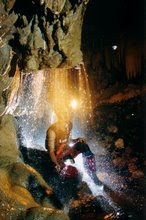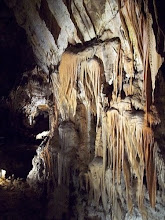Cave Tourism and Management
By
Robby K.T.Ko
Cave and Karst Scientist
Recognized Authority In
Cave Conservation and Management of Caves for Tourism
By The IUCN-The World Conservation Union (1999)
Contributor of the Biodiversity and Cultural Property in the
Management of Limestone Resources publication, Sponsored by
the World Bank and IUCN (1999)
Recipient of the American Biographical Institute’s Distinguished
Leadership Award for Outstanding Pioneering Work in
Karstospeleology (1990)
Recipient of the Award by the Indonesian Minister of Tourism,
Art and Culture, for Pioneering Work in Development of
Ecokarstology and Cave Tourism (1999)
Adjoint Secretary for the Austral-Asian Region of the
International Union of Speleology
President of the Federation of Indonesian Speleological Activities
(FINSPAC)
User’s Advisory Committee Member-Indonesian Biodiversity
Working Group Indonesian Science Institute
Resource Person in Cave and Karst Protection, Directorate
General of Tourism, State Minister of Environment and
Directorate General of Nature Conservation
MANAGE CAVES FOR TOURISM
R.K.T. Ko
Speleologist and Cave Management Consultant International
presentation on Cave Management at the IUCN-World Bank
Meeting On Limestone Biodiversity
Bangkok 25-27 January 1999
(1)
Caves have many different and important values. Each of
them must be identified, before utilizing caves for certain
purposes. Touristic potential is but one of those values.
(2)
It is mandatory to -as soon as possible- officially open a cave
to the public at large, and manage it professionally, when
they are already being visited by people for recreation.
(3)
Cave tourism at first sight seems to contradict cave
conservation. This should not be the case, since conservation
is not the opposite of development. It emphasized that
conservation includes both protection and the rational,
sustainable use of natural resources. So it is a matter of
professional management of these natural resources.
(4)
Cave management for touristic purposes means management
of the whole cave environment. It is not limited to
management of the underground environment only. Cave
managers should constantly keep in mind the existence of an
intimate surface - subsurface connection.
(5)
Any measures taken to develop caves for tourism, should be
based on a balanced consumer's-oriented and resource-
oriented approach. Developers and managers should
constantly look for compromising steps, How to satisfy
visitor's expectations and at the same time limit alteration of
the unique cave environment. Stick to the motto: safe the
visitors but also safe the caves.
(6)
The strategy to satisfy visitors and concurrently protect the
delicate cave environment can only be worked out, if these
management principles are strictly adhered to:
1. Identify the type of cave visit: ordinary visit
(commercial caves) or special interest cave
exploration (wild caves)
2. Determine the dynamic carrying capacity of each
cave.
3. Plan and implement the external and internal visitor’s
circulation pattern. Exit and entrance of commercial
caves should be separated. A one way traffic is most
suitable to protect the interior of a cave. It is allowed
to compromisingly build a man-made horizontal or
vertical tunnel to emerge from the caves as long as it
is very carefully planned and executed.
4. Periodization of a cave visit is mandatory. A fixed
time schedule of a cave visit should be adhered to.
5. Visitors of commercial caves should at all times be
guided by well trained and well informed
[professional] guides.
6. Wild-cave explorers must possess high ethical
standards. They must obtain special permits. Their
equipment and skills must be checked by a cave
guard. They ought to be skillful in performing self
rescue. No solo caving is allowed.
7. Cave guides should undergo a periodical health
check-up, their knowledge about speleology and
guiding principles upgraded periodically. To prevent
boredom, a scheme of duty rotation from one cave to
the other should be drawn.
8. Semi- annual or annual evaluation of cave
management and cave deterioration must be
undertaken. Visitor’s written comments are a valuable
source to take into account.
9. Only part of an extended cave or cave system may be
visited by ordinary tourists.
Closed to commercial cave visitors are: (1) cave
passages occupied by many cave bats, swiftlets and
other cave dwelling animals. (2) Passages which
cannot be negotiated through easy walking in an
upright position. (3) caves containing foul air so that it
is hard to breath (4) cave passages with many, very
fragile speleothems, unless protected by special
devices to prevent these cave decoration to be touched
by visitors. (5) passages prone to be flooded during a
rainstorm (6) underground stream ways. Unobtrusive,
non-eye catching bridges must be built to prevent
visitors entering cave rivers. (7) Difficult or
dangerous parts of the cave: slippery or muddy
passages, unprotected paths alongside steep
underground canyons, boulder strewn cave sections.
(8) Vertical cave sections which can only be
negotiated with special gears and skills. (9) Sections
of cave with unstable walls, ceiling and floors. (10)
unsurveyed sections of caves.
10. Installation of cave illumination needs special skills
and equipment. The eternally dark underground
environment will be disturbed by lights. Algae may
grow and destroy the delicate subterranean micro
ecosystem.
Cave animals are disturbed by light sources inside a
cave. Special lamps and placing [to enhance the
beauty of speleothems, cave rivers, waterfalls,
cascades, unique passages and ceilings]. And
periodicity of illumination should be planned in
advance and whenever needed, corrected. No devices
[cables, reflectors, lamp bulbs] may be exposed.
Visitors may only see the light beam or glow, but not
the light source. No colored lights are permitted
11. No devices producing noise may be installed in the
cave interior. Only for emergency, a two way
communication system can be installed at strategic
places.
12. Visitors are not allowed to bring into the cave food
and drinks. Nor are they allowed to raise their voice
unnecessarily. They must, at all times, move
themselves on established paths and stairways.
13. Path and stairways must be planned in advance, built
in accordance to the visitors circulation pattern, in and
outside the cave.
14. No devices may be installed inside the cave, which
are not necessary, likes statues, lamp posts, toilets etc.
A place to rest and to listen to the informative lecture
of the cave guide may be built, inside a large cave
section [semicircular row of uncolored benches made
of concrete].
15. No smoking is allowed in the cave interior.
16. It is strictly forbidden to take away or destroy any
cave decoration. Like cave pearls, stalactites,
stalagmites etc since these speleothems need hundreds
or thousands year to develop and once destroyed, will
always be destroyed.
17. Zonation of the exterior cave environment is of
crucial importance in management, identify the
1) Public zone, with sub zones for :
Parking, eating-drinking facilities, souvenir shops,
public toilet, ticketing, resting or waiting, praying,
play-ground for children etc.
2) Buffer zone, to demarcate the public zone from the
transition zone In the buffer zone can be built the
visitor’s center with display material, a small
museum, cave maps and maquette/model, video
documentation of cave exploration activities, etc.
Waiting room for cave guides are located here. A
row of toilets can be found here.
3) Transition zone, Where visitors are given a chance
to adapt themselves from the noisy outside world to
the eternally dark, silent underground environment.
This is the access towards the cave entrance. A
flight of stairs and hardened access road are the
only man-made structures allowed to be built. This
zone is only for visitors, guides and management
personnel. No vendors allowed.
4) Main visitor’s zones. The target of the cave visit,
with sub zones:
Cave entrance, intensive zone, where visitors
circulate, restricted sub zone. where only persons
with special permits or with special purpose may
enter (e.g. passages with cave animals are only
open to cave scientists with permits) and closed
subzone: dangerous passages.
(7)
Law enforcement is very important. Each country must
apply its law to protect the caves and their environment
from destruction and pollution.
(8)
Environmental impact analyses is by law required before a
cave is opened to the public. Special emphasis is put on:
1) Facilities for waste disposal (restaurants, toilets, fruit
stalls) which may be pollute the endokarst environment.
2) Hygiene and availability of uncontaminated drinking
water. Periodical monitoring of the water quality is of
utmost importance.
(9)
Security of the visitors must be assessed
(10)
Local in habitants must benefit from this cave tourism
activity. Multiplier effect must be encouraged. Influx of
highly competitive, experienced and wealthy non-residents
must be anticipated by and coped with, in order not to
squeeze the local, inexperienced entrepreneurs out of their
jobs.
(11)
Cave visit by the general public is considered more
attractive, if it is part of a package tour, to a nearby beach,
lake, waterfall, etc.
(12)
Sales promotion to caves sites, open to the public, is very
important. Brochures, frequent publication in diverse mass
media and involvement of a number of travel agents are
crucial.
7
(13)
Educational value of a cave visit must never be undervalued.
The first cave visit must give a lasting impression to a
novice. Well-trained guides and professionally managed
commercial caves are unmistakably a perfect media to instill
environmental awareness and conservation mindedness.
Guided commercial cave visits by small groups of students,
accompanied by teachers and parents, are acknowledged to
be very educative.
(14)
The role of an experienced speleologist in consultation for
cave development is of crucial importance. After initial
surveys, mapping and identification of diverse values of a
particular cave, he is expected to contact scientists in related
fields and make a multidisciplinary team to continue the
survey on a holistic base. This team will make a
comprehensive report of the exo- and endokarst phenomena,
the socio-economic and socio-cultural aspects, and assess the
potential value of marketing this commercial cave. This
team will also perform the environmental impact analyses.
(15)
Wild caves are more easily destroyed by unscrupulous cave
explorers than professionally managed commercial caves.
Many unexplored wild caves can also be potentially
dangerous. It is therefore a rational policy, that cave
expeditions and cave exploration should obtain special
permits from relevant officials.
Members of a wild cave survey team must deliver 1) their
curriculum vitae. 2) proposal of the cave survey 3)
recommendation of their local or national caving association
and in case of scientific research. 4) of their university and
5) national science institute. They must strictly follow the
rules and regulations imposed on them. 6) They must sign a
waiver of liability form and on arrival at the cave site, they
have 7) to report to the local police and village chief. 8) It is
a moral duty, that cave explorers send their complete reports
as soon as possible to the persons who, or the institutes that
have given them the recommendation and permits. .









